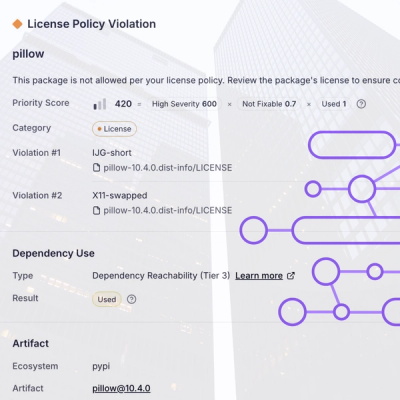
Security News
TC39 Advances 11 Proposals for Math Precision, Binary APIs, and More
TC39 advances 11 JavaScript proposals, with two moving to Stage 4, bringing better math, binary APIs, and more features one step closer to the ECMAScript spec.
react-use-rect
Advanced tools
Hook that is aiming to help you on tracking a DOM element boundaries
Utility hook that aims to help with tracking an element's bounding client rect.
It might be found useful for simple cases such as getting element's size and position once it mounts to the DOM. As well as for complex ones when an element position changes frequently and needs to be tracked down (e.g. dropdowns and tooltips).
For npm users:
npm i react-use-rect
For Yarn users:
yarn add react-use-rect
Let's examine a very simple case at first.
import { useState } from 'react';
import { Rect, useRect } from 'react-use-rect';
function Example() {
const [rect, setRect] = useState<Rect | null>(null);
const [rectRef] = useRect(setRect);
return <div ref={rectRef}>{rect && `This div is ${rect.width}px wide.`}</div>;
}
This hook doesn't make assumptions on how you'd like to manage a rect data: save it as a state, put it into a ref or not to store it at all.
In the example above we save our rect into a local state so we use the useState hook. However, it's possible to pass your own function to handle rect changes. Let's call it dispatchChange function.
const [rectRef] = useRect((rect) => console.log(rect.top));
return <div ref={rectRef} />;
The hook revalidates an element's bounding rect on every render but it calls dispatchChange only when the element's rect has changed.
You may want to revalidate the rect when the element's size chages not as a consequence of rendering (e.g. textarea being resized by a user).
In order to cover this need the resize option is introduced.
useRect(dispatchChange, { resize: true });
In the following example we'll be watching a textarea resize. Once it being resized we update styles of another element according to the textarea's rect.
import { useRef } from 'react';
import { useRect } from 'react-use-rect';
function Example2() {
const rulerRef = useRef(null);
const [rectRef] = useRect(
(rect) => {
if (rulerRef.current) {
rulerRef.current.style.top = `${rect.top + rect.height + 10}px`;
rulerRef.current.style.left = `${rect.left}px`;
rulerRef.current.style.width = `${rect.width}px`;
}
},
{ resize: true }
);
return (
<div>
<div
ref={rulerRef}
style={{
position: 'fixed',
height: 2,
background: 'red'
}}
/>
<textarea ref={rectRef} />
</div>
);
}
It's also possible to revalidate a rect when a user scrolled the document, or some transition ended or something else happend and you want to be sure the rect is updated. Just call the revalidate function manually.
const [rectRef, revalidate] = useRect(dispatchChange);
revalidate();
Note that both rectRef and revalidate functions a referentially stable and never change during a component lifetime.
If you want dispatchChange to be called regardless the rect has changed or not, use the force option.
revalidate({ force: true });
There is also a one tiny hook included that could come in handy – useWindowOn. You can use it to add an event listener to the window and then revalidate a rect once the event captured.
import { useState } from 'react';
import { useRect, useWindowOn } from 'react-use-rect';
function Example3() {
const [top, setTop] = useState<number | null>(null);
const [rectRef, revalidate] = useRect((setTop) => setBottom(rect.top));
useWindowOn('scroll', () => revalidate());
return (
<div style={{ height: '200vh' }}>
<div ref={rectRef} style={{ marginTop: 100 }}>
{top !== null && `I'm ${top}px from top.`}
</div>
</div>
);
}
interface UseRect {
(dispatchChange: DispatchChange, options?: Options): Result;
}
interface DispatchChange {
(rect: Rect): void;
}
interface Rect {
bottom: number;
height: number;
left: number;
right: number;
top: number;
width: number;
x: number;
y: number;
}
interface Options {
resize?: boolean;
}
type Result = [SetElement, Revalidate];
interface SetElement {
(element: Element | null): void;
}
interface Revalidate {
(options?: RevalidateOptions): void;
}
interface RevalidateOptions {
force?: boolean;
}
interface UseWindowOn<T extends keyof WindowEventMap> {
(eventType: T, callback: (event: WindowEventMap[T]) => void): void;
}
FAQs
Hook that is aiming to help you on tracking a DOM element boundaries
The npm package react-use-rect receives a total of 660 weekly downloads. As such, react-use-rect popularity was classified as not popular.
We found that react-use-rect demonstrated a healthy version release cadence and project activity because the last version was released less than a year ago. It has 2 open source maintainers collaborating on the project.
Did you know?

Socket for GitHub automatically highlights issues in each pull request and monitors the health of all your open source dependencies. Discover the contents of your packages and block harmful activity before you install or update your dependencies.

Security News
TC39 advances 11 JavaScript proposals, with two moving to Stage 4, bringing better math, binary APIs, and more features one step closer to the ECMAScript spec.

Research
/Security News
A flawed sandbox in @nestjs/devtools-integration lets attackers run code on your machine via CSRF, leading to full Remote Code Execution (RCE).

Product
Customize license detection with Socket’s new license overlays: gain control, reduce noise, and handle edge cases with precision.